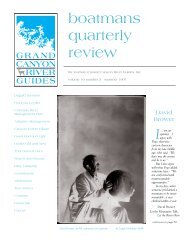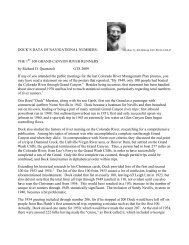boatman's quarterly review - Grand Canyon River Guides
boatman's quarterly review - Grand Canyon River Guides
boatman's quarterly review - Grand Canyon River Guides
Create successful ePaper yourself
Turn your PDF publications into a flip-book with our unique Google optimized e-Paper software.
spillways, and they knew the spillways were gonna have<br />
problems—especially when they lose the sweep at the end<br />
of it. A normal, good hydraulic spillway, when it works, is<br />
that water, as it comes out of the spillway, out of the end of<br />
the tunnel, should have a nice smooth sweep to it, so<br />
when it hits the end of the flip bucket at the end, it’s<br />
thrown way up in the air, and then out into the channel<br />
itself. When everything is workin’ right, it’s a very nice,<br />
smooth, very beautiful…[indicates upward arc]…Yeah,<br />
that’s how it should look. You’ve got all that kinetic energy<br />
of all this water going at roughly 125 mph, comin’ down<br />
that spillway. You gotta find some way to get rid of that<br />
energy. So what they typically do on spillways is throw it<br />
up in the air, so that some of that energy is dissipated in<br />
the air before it comes back down in the water. Well, what<br />
was happening in Glen <strong>Canyon</strong> is that you could stand<br />
either at the base of the dam, or overlooking it, and the<br />
water wasn’t sweeping—there was no sweep to this<br />
water—it was actually surging. If you take a look at some<br />
of the old videos, you can still see it. This water surges back<br />
and forth, it pulsates, and that’s not good hydraulics,<br />
because that means that you don’t have good sweeping<br />
hydraulic flow, good laminar flow comin’ through. And<br />
then you started to see chunks of stuff come flyin’ out of<br />
there.<br />
Steiger: And you saw this yourself<br />
Wegner: Oh, yeah.…you started to see chunks of stuff<br />
come flyin’ out of the spillway there. Well, they knew this<br />
was gonna happen, because it had happened the year<br />
before at Yellowtail Dam…There was concern in Salt Lake<br />
City, obviously, that you open the spillways, and somethin’s<br />
gonna happen. So we were takin’ extra water<br />
samples and just tryin’ to keep track of what was<br />
happening. But when the end of the spillway tube started<br />
to surge, and then you saw things come flyin’ outta<br />
there…the engineers knew immediately what was goin’<br />
on, and they were pretty smart about this. Wasn’t a total<br />
shock, ’cause like I say, it had happened earlier at Yellowtail,<br />
which was the same sort of spillway design. So they<br />
knew this was probably gonna happen again—and lo and<br />
behold, it did. Then the river started to turn sandstone<br />
color comin’ out of the spillway, so you knew it’d gotten<br />
through that eleven feet of concrete, and it was into the<br />
abutment, which at that point the Bureau shut the spillways<br />
down. Actually, they were shuttin’ ’em down all the<br />
time, to go in and check, and that’s why they knew the<br />
damage was occurring. They’d send those guys down in<br />
those little carts. How would you like to be the guy who<br />
goes down there You know, to take a look at what was<br />
there. Then finally they shut ’em totally off, and they sent<br />
one guy on the cart down there. Here you are, you’re goin’<br />
down into the maw of the giant down there, not knowing<br />
what you’re gonna find. You’re on this cable, being<br />
lowered down there on essentially a go-cart type of frame,<br />
and they found the hole, and it was a big hole. So then the<br />
question became essentially, “Do we continue to run the<br />
spillways…” ’cause the reservoir was still comin’ up and up<br />
and up. “Do we run the spillways and incur more damage,<br />
or are there alternative ways to handle this” And the<br />
alternative way was where, “Well, let’s put the reservoir<br />
into what they call surcharge,” which means go higher<br />
than it’s supposed to go.<br />
And that’s where the plywood came in, because they<br />
essentially had to go scrounge up marine-grade plywood in<br />
Page to slap on, because the weak link is the top of the<br />
spillways, ’cause it’s lower than the crest of the dam…And<br />
so they slapped on this marine plywood and they held for<br />
almost a week or so, until they got a contractor in on an<br />
emergency basis to build the steel spillway gates, which<br />
went on over the 4th of July weekend.<br />
Brad Dimock: Those went up eight or twelve feet—<br />
those steel ones<br />
Wegner: Well, the plywood was eight feet, but the<br />
steel ones, I think went up eleven feet, but we could check<br />
on that for you.<br />
Dimock: The plywood was sideways at four feet<br />
Wegner: I think they had two levels on it at one point,<br />
but we should check on that.<br />
Steiger: Now, the guy runnin’ the dam was Tom<br />
Gamble<br />
Wegner: Tom Gamble, yeah.<br />
Steiger: Were you present when they made that decision<br />
or anything<br />
Wegner: Well, I wasn’t in his office. That decision was<br />
made with Tom Gamble, and it was made with Upper<br />
Colorado Region folks—Wayne Cook and John<br />
Newman—and probably the Denver folks, I would<br />
imagine, were in this discussion also. I wasn’t there when<br />
they made the decision, but I was there when they were<br />
starting to slap the plywood on there…All four of the<br />
hollow jet tubes were wide open, the generators were goin’<br />
full bore. The only other option was to use the spillways,<br />
and hope to God that it eroded into the sandstone abutment<br />
and not into the dam. But there was no given on<br />
that, nobody knew what would happen. There were a lot<br />
of anxious days there, hours, when even with the steel<br />
gates on the dam on the top of the spillways, when was it<br />
gonna stop<br />
And there was a huge collective sigh of relief when it<br />
peaked out and the water actually started to go down a<br />
little bit. Of course once it had started goin’ at Glen, it just<br />
dominoed throughout the rest of the Colorado <strong>River</strong><br />
system, and Hoover spilled, and all the dams downstream,<br />
they flooded out all those folks who had moved in along<br />
the Lower Colorado <strong>River</strong> and the water actually got to<br />
the Sea of Cortez—imagine that! I think there’s actually<br />
still some lawsuits down in Mexico that haven’t been<br />
resolved yet on that whole 1983 thing.<br />
Amazing things were going on. The amazing thing is<br />
that 1984 was actually a higher water year. They had just<br />
boatman’s <strong>quarterly</strong> <strong>review</strong> page 29
















